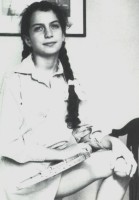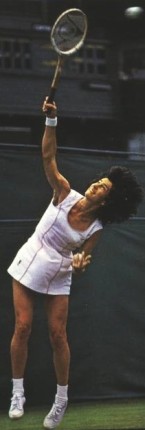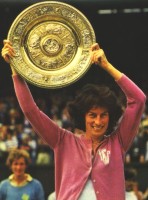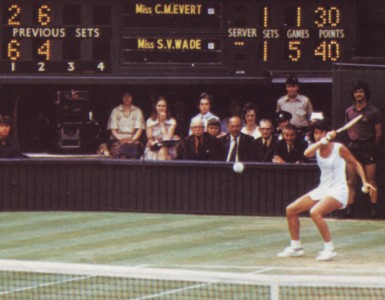Out of print, but still readily obtainable used from Amazon.com via the link above.
Virginia Wade is an exceptionally intelligent and articulate woman, and Courting Triumph is a very well-written book. The narrative alternates between a description of her 1977 Wimbledon final victory over Betty Stove, and a biography of the rest of her life. Learning to love the game after finding a tennis racquet while cleaning a closet at age 9 in Durban, South Africa, Virginia had the good fortune and skill to go on to win the first tourney of the "open" era at Bournemouth, the first US Open, and the 100th Wimbledon.
Courting Triumph is a really, really good book, and leaves the reader wishing there were more of it. The book also includes many very nice photos, 40 black & white and 9 color (plus 2 more on the dust jacket). It is well worth the few dollars it costs to order a used copy.
|
1968, and the 1st US Open (pages 105-111) Bournemouth, in 1968, was the site of the first Open [tournament open to both amateurs and professionals, paying prize money to the pros] with first-prize money of eight hundred pounds for the men and three hundred for the women. I won, but--both because my status was uncertain and because the prize money was so much lower than the men's--with my ice-blue eyes blazing, I arrogantly, gloweringly, scowlingly refused the money! [After Bournemouth, Virginia led the British Wightman Cup team to their first win over the US in many years.] Wimbledon arrived. It rained for three and a half days. I had some crazy idea that the confusion of rushed practice on the wood at Queens would be more detrimental than not practicing at all. At 7:30 on a Thursday night, I was put on court No Two against Christina Sandberg, a relatively unknown Swedish girl whom I'd beaten comfortably before. After so many days off I was glad to play. That didn't last long. I felt as though I hadn't been on a court for weeks. With all that rain, it was more like a duck pond. As I skidded around in an ever-increasing spiral of bewilderment, Christina had merely to keep the ball in court to beat me. ...I did win the Plate, the consolation event for first-round losers... ...I thought of quitting, reassessing the whole thing and starting over again if I felt like it. There was even doubt in my mind whether I should play the next big tournament, Forest Hills. It was the first US Open Championships, with a large purse, but you had to win a few rounds to cover the airfare. I wasn't used to fending for myself. Till then all my fares had been already covered. I was rather pessimistic about the whole event. Forest Hills was always a struggle. The dressing rooms were over-crowded and uncomfortable. The courts were dreadful. All the European players referred to them as cow pastures... I decided to play, with the emphasis not on winning, but on suffering emotionally as little as possible on court... The usual obstacles disappeared. My serve troubled me briefly, but there was Doris Hart waiting to give me advice. It took ten minutes of her expertise to set me straight. My draw was tough, but none of my opponents was a personal bÍte noire... In the round of sixteens, I had to play Rosie Casals. As we walked down the path to the stadium, she grumbled about the tournament, the early hour of the match, the balls, etc. For an instant I felt the old familiar feeling creeping over me. Then, as quickly as it came, I discarded it and thought, "I'm feeling great. I'm looking forward to this match. Use it in your favour that Rosie likes to sleep late." Rosie and I usually played close, exciting matches. Neither of us could resist the temptation to go for spectacular effects, nor had the slightest belief in half measures. If the audience could not be moved to wonder and applause, the game was hardly worth playing. This was a typical match. We both had successions of good points. Fortune fluctuated back and forth between us, but the composure and eagerness I felt before the match survived. I won 6-4, 7-5. A sigh of relief issued from me. I'd covered my airfare from London and justified my No 6 seeding. Next, I confronted Judy Tegart, probably the most exuberant of all the players. We played a similar type of game only hers was more beefy and bouncy and less improvised than mine. I had a few more wins in our head-to-head record. She was at her peak though, having reached the final of Wimbledon earlier that summer. I expected a fight. Before I knew it, I'd won the match, 6-2, 6-3. It was so easy, winner after winner streaming from my racquet... I had reached the semifinal of Forest Hills and it hadn't even been difficult. The others had struggled to reach their spots. Maria Bueno had beaten Margaret Court, Ann Jones and Billie Jean had had no easy route. There was no problem getting geared up to play Ann. We were constant rivals for the British top ranking. While I was playing so well I was going to make sure I did my best to beat her. We were total opposites in style and temperament. Ann was the shrewdest competitor in the women's game; a realist, industrious, accurate, conscious of her own powers and doing everything possible within her limits. It was Head versus Heart; sophisticated tennis versus natural ability. I had beaten her three out of the last four matches we'd played, so it wasn't surprising that I did win the semi, but the margin was, as the New York Times said, "impressive". There was general astonishment that my concentration never wavered, that I played such a mature match at such a vital time. In 43 minutes it had been neatly parcelled and packaged: 7-5, 6-1. ...I slept well that night in my room at the Roosevelt Hotel. I didn't think too much about tennis. In the morning I was raring to go. There were a few good luck telegrams from home and a call from Maureen Connolly. "Little Mo" had helped me more on my game than anybody else. She wished me luck and told me I could win it. That call meant a lot to me. |
 Virginia while in high school  serving to Betty Stove in the 1977 Wimbledon final  1977 Wimbledon champ photos from the book |
|
The day dragged on forever. The match between Billie Jean and myself was scheduled at five o'clock after the men's singles semifinal... ...Finally Arthur Ashe beat Clark Graebner. It was closer to 5:30. Shadows were coming over the court, but no one in the capacity crowd moved from his seat. I didn't think about the match. It was my first really big final and for the first ten minutes I was trembling with nerves. Once they evaporated I was completely involved in the tennis. I loved every one of the forty-two minutes it took me to beat Billie Jean. To me, my game seemed over-simplified, almost dull, percentage first serves, decisive but unflashy volleys. I kept expecting to have to produce more, but it wasn't necessary. I won 6-4, 6-2. I was the first US Open champion. | |
|
Other players (pages 137-143) How have players like Margaret Court, Billie Jean King, Chris Evert, Maria Bueno produced such formidable records? Margaret won with imposing regularity. She so adamantly refused to quit, even when she was looking down the barrel of a gun, that I used to wonder whether a loss for her was the total embodiment of failure. With Billie Jean it's not so much the loss that she is avoiding as the win she wants. Margaret's record was gargantuan... The outcome wouldn't depend on the other player's level of brilliance that day... I remember playing her in the semifinal of Forest Hills in 1969, on a court squelching with rain. Neither of us was great, we were very even. I led 5-4 and 40-0 on her serve. She came up with a series of points that totally ignored my prescence on the other side of the net. From then on she never put a foot wrong and I was wiped out. ...She would always say: "Two hours a day isn't very long to concentrate." As for Billie Jean, there is no such uniformity of mood... ...She's permanently fascinated by the game. Day after day in Team Tennis, she's experimenting with different shots or playing around with ideas at the drawing-board stage. ...Billie Jean's always striving for an improvement... She'll find some instances in a match after she comes off that weren't up to her standards of perfection and set herself out to correct them... Chris Evert is yet another type of winner. She enters a cocoon the moment she goes on court. It's as though she flicks on a switch and automatically she is in a frame of reference where all that matters is her apparatus working at precision efficiency. Day after day she produces infallible tennis... She plays with the same clinical approach against lesser and greater opponents alike. The excellence of her tennis alone, and the self-assurance that she belongs in the top niche, serve to ensure that she doesn't fall beneath. Maria Bueno was probably the player with the most prescence and grace on the court... She was a heroine in Brazil. Two statues stand in her honor in S„o Paolo. If her subjects wished to send a letter they could do so with a postage stamp bearing her image. She knew she was the most dazzling and demanded player... she's been a perennial and sentimental favourite of any fortunate audiences for whom she still occasionally performs. |
 | The Wimbledon Centre Court scoreboard shows match point as Virginia Wade delivers a forehand during her 1977 ladies singles semifinal against Chris Evert. Virginia advanced to defeat Betty Stove in the final, becoming the last British woman to win the singles title at Wimbledon. About the '77 semifinal, Virginia later said: "I played my best tennis of the tournament - and possibly my career - in that match." photo from the book |
|
Wimbledon final vs. Betty Stove, July 1, 1977 (pages 19-169) I've been here sixteen years in a row and have never managed to catch sight of it. Now barring anything short of divine intervention, it's straight ahead. The long-sought-after light at the end of a sixteen-year-old tunnel. I've played this tournament for exactly half of my life. I'm in the final for the first time. The Queen is watching. Everybody is watching. I'm going to win this thing if I have to kill myself to do it... I was a break down at 4-5 with Betty serving for the first set. The previous time I'd lost my serve at 2-2 I immediately won hers back, but on grass against a player with a big serve, you cannot reasonable expect to break too often... ...At deuce I did my best but was beaten by a better shot. With Betty on the verge of winning the set there was grudging applause. The next point I scrambled back three or four balls and had an opportunity for a winning backhand volley to save set point, but I put it straight onto her racquet and lost the point. The scoreboard flickered like a pinball machine. With a flurry of lights, the little silver ball had escaped through the gap. The arrangement of lights came to rest showing a 4 by Wade and a 6 by the name Stove with an extra bonus of 1 under sets. I felt no qualms. I had tried to get the first set over with too quickly and had rushed it. Now, after forty minutes, I knew I'd have to stay out there a lot longer; all afternoon if necessary. With all respect for Betty there was no way I was leaving that court the loser... [4-6, 1-0] ...I could feel the momentum turning. On Betty's serve I played a much better game. My shots were more solid and flowing. I went for them and immediately my anticipation improved. I hit a forehand passing shot for a 2-0 start... I served well and hit more good ground strokes than I had the entire match. My footwork was better too; nice compact quick steps instead of longer, less co-ordinated strides. On a tennis court the short, quicker paces are the most efficacious. It's easier to arrive at the ball on the correct foot and make quick turns. That's why height is not always an advantage. [4-6, 5-3] I served an ace to line myself up with two set points. At 40-15 I went for a big serve down the middle. The crowd cheered and clapped. They had to laugh at themselves. I smiled briefly, knowing that I, too, had hoped it was in. Betty shook her head at them. With all those people yelling against her, I couldn't blame her. She won that point with a fine backhand volley. Another chance. The serve hit the spot I wanted. I got a short return to come in on and slid my backhand onto her baseline; she made a classic lob deep and high over my right shoulder. I scooted back, climbed right up in the air for it, extended from one extremity to the other and crunched it. I couldn't have asked for a better point on which to win a set. [4-6, 6-3, 4-1] ...Just because I had a good record against Betty didn't mean I could relax. She's much to tough a competitor. She'd also already beaten Martina Navratilova and Sue Barker en route to the final. I carried on with my service game. There was a comparative hush as we played each point out, followed by precipitate applause as I won one more point, then another. I was 5-1 up. I needed only one more game, only four more points. Betty took the new balls to serve. She served way out to my right. The ball seemed to have passed me, but I swooped out at it. I just got my racquet on it. It skimmed through the air. Betty thought she'd aced me and when it landed on her side she wasn't there. She shook her head incredulously. The points rolled past... I reached 15-40. Two match points to me. I raced to the ball; it was too good. I even slipped in my effort. Second match point. Betty served wide to my backhand on the left court. It skipped off the tape and into the tram-line. Fault. She tossed the ball up for her last serve. I moved around to take it on my forehand; I went down the line at her feet. She bent for the forehand volley. It was too low; too wide. The return was perfect. There was a tumultuous explosion. I sprinted to shake hands. What could I say but "Thanks" to Betty. She patted my head; she graciously offered congratulations. ...the umpire began to make an announcement. "Ladies and Gentlemen," I listened wondering what he was going to say. "The score was 4-6, 6-3, 6-1." ...The Queen was leaving the Royal Box. ...Like an actor frozen backstage, I felt the hand of the stage manager shoving me towards Her Majesty. I curtsied and shook hands. The plate was in my grasp. ...The next thing I remember was Betty encouraging me to hold the salver higher. It had been a tough afternoon for her. There was every reason for her to feel excluded, but she joined in with the gallantry of a great sport. The voices of "Over here, Virginia!" were drowned by probably the first chorus of "For She's a Jolly Good Fellow" ever heard on the Wimbledon Centre Court. |
Virginia Wade was born July 10, 1945 in Bournemouth, England, where her father was vicar of Holy Trinity Church. The family moved to South Africa in 1946, before Virginia was 1. After finding a racquet while cleaning out a closet at age 9, she played tennis "every single minute I wasn't obliged to do something else." Soon she was "invincible" in under-eleven junior tourneys.
When Virginia was 15 the family moved back to England, in fact, to Wimbledon, the London suburb where the All-England Tennis and Croquet Club is located and holds their famous Championships. By age 16 Virginia was considered the most promising junior player in England, and she qualified to play in the Championships at Wimbledon. She continued to play at Wimbledon every year through 1987--26 years in all.
Virginia won 55 pro singles titles, including 3 Grand Slam tourneys (1968 US Open, 1972 Australian Open, 1977 Wimbledon). She was ranked in the top 10 in the world for 13 years, from 1967 to 1979, and was ranked # 2 in 1968.
Virginia Wade page at the International Tennis Hall of Fame
Wimbledon.org: Wade's Jubilee Victory
Find more books by or about Virginia Wade at Amazon.com
Find tennis shoes made by: adidas -- Nike -- Fila -- Reebok
Find tennis racquets made by: Yonex -- Wilson -- Head -- Prince -- Babolat
Find tennis balls made by: Wilson -- Dunlop -- Penn -- Tretorn -- Slazenger
Tennis pages at quickfound.net:
- Tennis History Book Excerpts:
Courting Triumph by Virginia Wade with Mary Lou Mellace
Chrissie: My Own Story by Chris Evert with Neil Amdur
Tennis Styles and Stylists by Paul Metzler
The Game by Jack Kramer about Pauline Betz & Gussy Moran & more
Beyond Center Court: My Story by Tracy Austin with Christine Brennan
Courting Danger by Alice Marble with Dale Leatherman
Evonne!: On the Move by Evonne Goolagong with Bud Collins
Court On Court: A Life in Tennis by Margaret Smith Court
Goddess & the American Girl: Suzanne Lenglen & Helen Wills by Larry Englemann
Hard Courts by John Feinstein about Mary Carillo & John McEnroe & more
Ladies of the Court by Michael Mewshaw about Mary Joe Fernandez & more
A Long Way, Baby by Grace Lichtenstein about Rosie Casals
Tough Draw by Eliot Berry about Nick Bollettieri
Monica by Monica Seles & My Aces, My Faults by Nick Bollettieri Seles at Bradenton
The Courts of Babylon by Peter Bodo: Tournament Draws
The Courts of Babylon by Peter Bodo: Dawn of the Pro Tours
- Tennis Articles
1946 TIME: Pauline Betz, Doris Hart, Beverly Baker, Gussie Moran
plus current tennis article feed
1951 & 1952 TIME: Maureen Connolly - Tennis News and Links
- WTA 2004 Desktop Wallpaper
- Justine Henin-Hardenne Desktop Wallpaper
- Maria Sharapova Desktop Wallpaper
- Anastasia Myskina Desktop Wallpaper
- Anna Kournikova News and Links
- Anna Kournikova Desktop Wallpaper
- Martina Hingis News and Links
- 2004 WTA Player Interview Videos
This page's URL is: //tennis.quickfound.net/history/virginia_wade.html